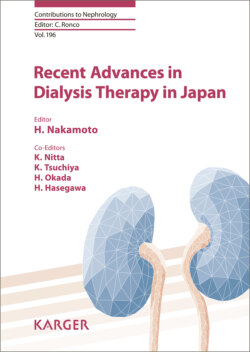Читать книгу Recent Advances in Dialysis Therapy in Japan - Группа авторов - Страница 10
На сайте Литреса книга снята с продажи.
Abstract
ОглавлениеBackground: Renal replacement therapy is vital for patients with chronic renal failure. Each type of renal replacement therapy has its own characteristics, and patients select it according on their living environment or conception of quality of life. Under the recent medical environment in Japan, economic burden of dialysis is another concern. For patients with chronic renal failure, the outcome of dialysis is vital. How to prevent or control side effects and complications is also important. One type of dialysis treatment is called peritoneal dialysis. Complications from long-term peritoneal dialysis include encapsulating peritoneal sclerosis (EPS), which can lead to life-threatening intestinal obstruction. Here, we hope to prevent the incidence of EPS through examining new possibilities in the pathogenesis during peritoneal dialysis and considering countermeasures. Summary: Membrane dialysis is a treatment methodology that makes use of the semipermeable function of body membranes. When the composition of the peritoneal dialysate is adjusted, it also removes waste products and adjusts water level. Chemical stimuli of peritoneal dialysate on peritonea can trigger inflammation and, when long-lasting, the latter is considered to cause EPS. For the body, chemical stimuli are invasive. Damaged body tissues have a capacity to repair themselves. The innate immune system is known to work in response to nonspecific stimulation, and so it is well conceivable that it is active in the abdominal cavity under peritoneal dialysis. Among many inflammatory cells involved in the innate immune system, we focus on the role of eosinophils to consider the possibility of unknown pathogenesis. Key Messages: Eosinophilic inflammation may cause EPS.
© 2018 S. Karger AG, Basel
Renal replacement therapies are life-supporting medical practice for patients with chronic renal failure. Hemodialysis is superior in efficiency but comes with many constrains in their everyday life. Peritoneal dialysis (PD), on the other hand, is significantly superior in terms of patients’ quality of life. In recent years, the combination of both is also receiving attention as a possible solution [1].
